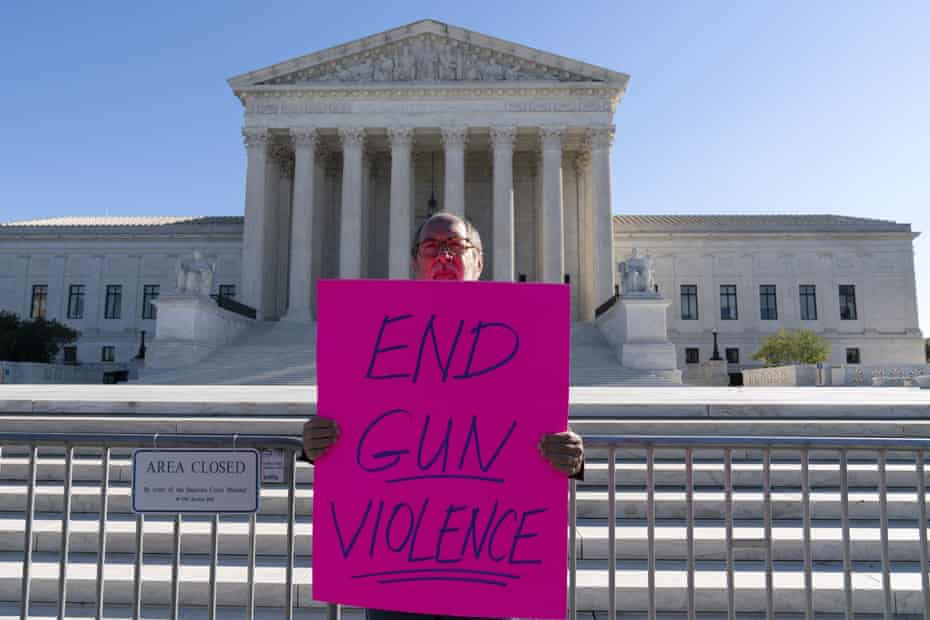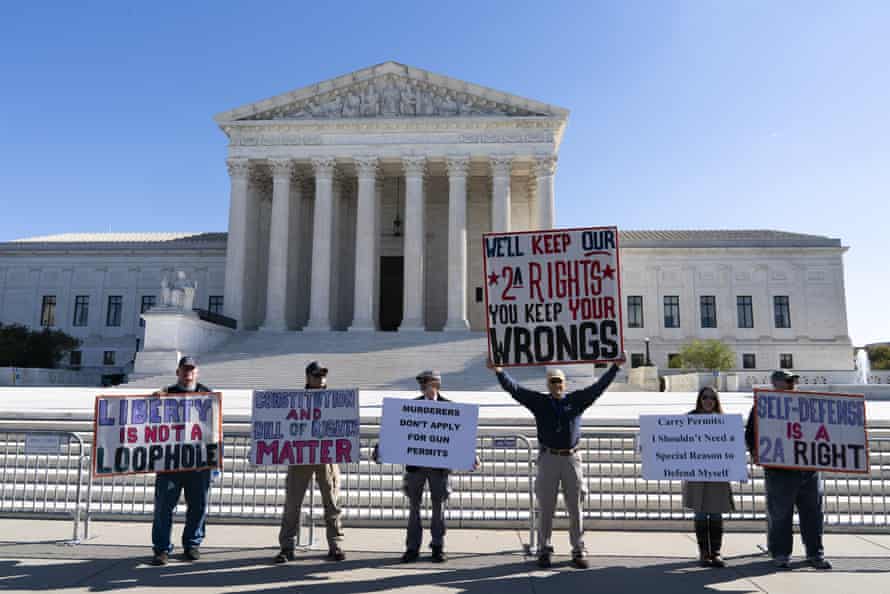Trump’s presidency saw three new rightwing judges, each backed by the powerful gun lobby movement

The supreme court is set to hear arguments in a New York
gun rights case that could have an effect on second amendment rights.
Photograph: José Luis Magaña/AP
Oliver Laughland
THE GUARDIAN
Oliver Laughland
THE GUARDIAN
Sun 29 May 2022
As the world looks on in horror following mass killings in Buffalo, New York and Uvalde, Texas, the US supreme court is set to issue its first major ruling on gun rights in over a decade.
And with a conservative super majority now installed on the bench, most onlookers expect a substantial broadening of second amendment rights in the country despite the widespread revulsion at the latest shootings in a supermarket and a school.
Although such a decision may seem incongruous with the outpouring of grief and anger after the murder of 19 Texan elementary school students and two teachers at the hand of an 18 year-old assault rifle wielding gunman earlier this week, it would also be in keeping with the creeping rightwing extremism on America’s highest court.

Washington’s shame: how previous bids to tighten gun laws have failed
A far reaching legacy of Donald Trump’s four years as president, which saw the installation of three rightwing judges, each backed wholesale by the powerful gun lobby movement.
“Before the Trump appointees were on the supreme court, the court had multiple opportunities to take cases that could expand second amendment protections, but it repeatedly turned those efforts aside,” said Adam Winkler, a supreme court and gun policy specialist at UCLA law school. “Now we see that the supreme court is taking big gun cases and seems prepared to issue a very expansive ruling. This is directly attributable to the 2016 election.”
Before the court comes New York State Rifle & Pistol Association v Bruen, a case challenging a New York law limiting concealed handgun carry in public. The law, more than a century old, requires residents to obtain concealed carry licenses by demonstrating they face a “special or unique danger to life” requiring firearms possession in public.

As the world looks on in horror following mass killings in Buffalo, New York and Uvalde, Texas, the US supreme court is set to issue its first major ruling on gun rights in over a decade.
And with a conservative super majority now installed on the bench, most onlookers expect a substantial broadening of second amendment rights in the country despite the widespread revulsion at the latest shootings in a supermarket and a school.
Although such a decision may seem incongruous with the outpouring of grief and anger after the murder of 19 Texan elementary school students and two teachers at the hand of an 18 year-old assault rifle wielding gunman earlier this week, it would also be in keeping with the creeping rightwing extremism on America’s highest court.

Washington’s shame: how previous bids to tighten gun laws have failed
A far reaching legacy of Donald Trump’s four years as president, which saw the installation of three rightwing judges, each backed wholesale by the powerful gun lobby movement.
“Before the Trump appointees were on the supreme court, the court had multiple opportunities to take cases that could expand second amendment protections, but it repeatedly turned those efforts aside,” said Adam Winkler, a supreme court and gun policy specialist at UCLA law school. “Now we see that the supreme court is taking big gun cases and seems prepared to issue a very expansive ruling. This is directly attributable to the 2016 election.”
Before the court comes New York State Rifle & Pistol Association v Bruen, a case challenging a New York law limiting concealed handgun carry in public. The law, more than a century old, requires residents to obtain concealed carry licenses by demonstrating they face a “special or unique danger to life” requiring firearms possession in public.

A ruling is expected soon on a case challenging a New York law limiting concealed handgun carry in public.
Photograph: José Luis Magaña/AP
Oral arguments were held in November 2021 with a ruling expected soon, and although observers expect a judgment striking the law down, just how expansive that ruling becomes is key to anticipating the seismic nature of the decision.
Around half a dozen states have similar concealed carry laws to New York that would likely be struck down by the ruling. But, said Jake Charles, a lecturer at the center for firearms law at Duke University, the argument behind the ruling itself could be critical to further expansion of gun ownership rights across the country.
“The court is going to make a decision about how lower courts should even consider the constitutionality of gun laws,” said Charles. “If it [the supreme court] adopts a test that says courts can only look to history, they can only look at the text of the constitution or to history to determine whether or not a gun law is constitutional … that is going to open up every other gun law that there is.”
It was 2008 when the supreme court last handed down a major second amendment ruling, in the District of Columbia vs Heller decision, which found it was constitutional for Americans to keep firearms at home for self-defense. But contained within that ruling, written by former justice Antonin Scalia, was wording that limited the scope of the judgment and, by extension, interpretation of the second amendment itself.
The decision noted gun ownership rights were “not unlimited” and does not translate to a “right to keep and carry any weapon whatsoever in any manner whatsoever and for whatever purpose”. The explicit wording has been used since by lower courts to uphold gun restrictions in the aftermath.

The supreme court ruling in the New York case is likely to pave the way for further decisions.
Photograph: José Luis Magaña/AP
But the new rightwing extremism on the supreme court is now likely to threaten that legal status quo. And despite the NRA’s internal leadership crisis and ongoing legal jeopardy (at the hands of the New York attorney general) the pro-gun lobby is gearing up for a major victory after the installation of three NRA-backed justices on the nation’s highest court.
“In terms of constitutional law, the NRA has never been stronger,” said Winkler. “Those three justices on the supreme court are going to embrace the broad vision of the second amendment that the NRA has been promoting for the last half century.”
The ruling in Bruen is likely to pave the way for further decisions as other cases involving state gun restrictions make their way up to the legal ladder. Last year the NRA petitioned the supreme court to hear a case challenging a law in New Jersey that restricts firearms magazines to 10 rounds. While gun advocates in Hawaii have taken a case challenging the state’s restrictive open-carry laws to the supreme court as well.
It is, said Charles, extremely unlikely the events in Buffalo or Uvalde will have any bearing on the Bruen decision itself. “If it did have an effect, my guess would be that it affects when they’re going to issue the decision and less what the decision is.”
But, said Winkler, if the court rules the way it is expected, the decision will become another indication of the opinions of a minority of Americans determining the national legal landscape.
“The supreme court has historically been a voice for the protection of minorities. However, the court today is not protecting racial or political minorities. The court is protecting a very conservative agenda, a conservative constitutional vision that is really not shared by the public at large.
“I think the court will run some risks in terms of its public legitimacy if it insists on a series of rulings that don’t stay within the broad parameters of widely shared public opinion.”
But the new rightwing extremism on the supreme court is now likely to threaten that legal status quo. And despite the NRA’s internal leadership crisis and ongoing legal jeopardy (at the hands of the New York attorney general) the pro-gun lobby is gearing up for a major victory after the installation of three NRA-backed justices on the nation’s highest court.
“In terms of constitutional law, the NRA has never been stronger,” said Winkler. “Those three justices on the supreme court are going to embrace the broad vision of the second amendment that the NRA has been promoting for the last half century.”
The ruling in Bruen is likely to pave the way for further decisions as other cases involving state gun restrictions make their way up to the legal ladder. Last year the NRA petitioned the supreme court to hear a case challenging a law in New Jersey that restricts firearms magazines to 10 rounds. While gun advocates in Hawaii have taken a case challenging the state’s restrictive open-carry laws to the supreme court as well.
It is, said Charles, extremely unlikely the events in Buffalo or Uvalde will have any bearing on the Bruen decision itself. “If it did have an effect, my guess would be that it affects when they’re going to issue the decision and less what the decision is.”
But, said Winkler, if the court rules the way it is expected, the decision will become another indication of the opinions of a minority of Americans determining the national legal landscape.
“The supreme court has historically been a voice for the protection of minorities. However, the court today is not protecting racial or political minorities. The court is protecting a very conservative agenda, a conservative constitutional vision that is really not shared by the public at large.
“I think the court will run some risks in terms of its public legitimacy if it insists on a series of rulings that don’t stay within the broad parameters of widely shared public opinion.”

No comments:
Post a Comment